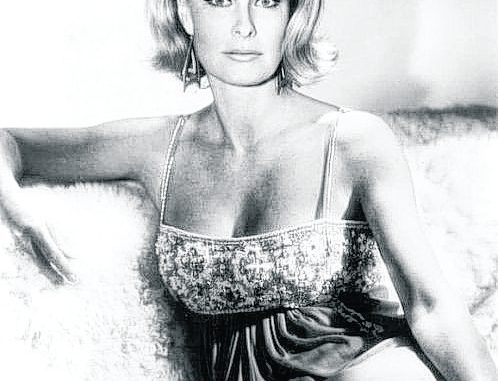
Nedenia “Deenie” Marjorie Hutton, who also went by Dina Merrill.
ohn Engstead/Helen Ferguson
As the child of fabulously wealthy parents, she grew up surrounded by 1920s luxury: Her summer home was a lavish 177-acre Tudor estate in the millionaires’ playground in Brookville on Long Island’s Gold Coast, and winters were spent at Mar-a-Lago, the magnificent 115-room Mediterranean-Moorish ocean-to-lake Palm Beach, Florida mansion and grounds which Donald Trump bought in 1985, before he was elected president of the U.S. Between seasons her family took long cruises aboard Sea Cloud, their private yacht, luxuriating on the islands of the Caribbean, the Galapagos, and other far-flung ports, or took off to explore the wild blue yonder in their turboprop jet, the Merriweather.
But for Nedenia “Deenie” Marjorie Hutton, the opulence and over-the-top residences were not enough. Defying her parents, she dropped out of college, followed her heart, and became a movie star, calling herself “Dina Merrill.” The regal aristocratic beauty succeeded at her dreamed-of craft and earned the title Tinseltown bestowed on her: “Hollywood’s new Grace Kelly.”
MILLION-DOLLAR ACTRESS
Her family’s Brookville estate was completed in 1929, six years after Nedenia was born in New York City, the only child of philanthropist/collector/businesswoman Marjorie Merriweather Post and her second husband, financier Edward Francis Hutton. Post inherited the fortune amassed by her father, C.W. Post, founder of the Postum Cereal Co. Ltd., later named General Foods Corporation.
Nedenia’s parents worked together to develop such popular food products as Birdseye frozen foods; on her own, Marjorie, the female mogul many dubbed “the Post Toasties heiress,” concentrated on creating an Old English country escape boasting formal gardens, horse stables, a working farm, and manicured lawns, all tended to by a staff of 100. Named “Hillwood,” the estate, sold to Long Island University by Marjorie in 1951, would later become C.W. Post University then LIU Post.
Young Nedenia Hutton got the acting bug when she was 8, performing in a Gilbert and Sullivan operetta at the Green Vale School, a private Old Brookville school. According to The New York Times, her father wanted her to become a lawyer and then run for Congress. However, as she told the Times in 1979, ”My ambitions were my own — not exactly the ones they had for me.”
After a year at George Washington University, Merrill enrolled at the American Academy of Dramatic Arts in New York and paid her thespian dues at a regional theater, painting scenery, sewing costumes, and acting in occasional bit parts.
Merrill would later remark, in 2000, “Of course, my parents’ eyebrows shot up when I said I wanted to be an actress. And I guess they said, really between themselves, ‘Let the dear girl try and fall on her face.’” The Times reported that although her father’s investments had earned her a million dollars by the time she became an actress, against his wishes, Ms. Merrill was supporting herself by modeling clothes for Vogue magazine at $10 an hour.
But she turned down the acting life after her mother “brainwashed” her, as she put it, to marry Stanley Rumbough Jr., heir to the Colgate-Palmolive fortune. In 1960, the Rumboughs built an oceanfront home in East Hampton and set about raising a family; after the birth of their third child, she resumed modeling and acting in TV programs. In 1993, with decades of appearances on film and television under her belt, she remarked: “I loved the make-believe …. It’s interesting to lead other people’s lives.”
DRAMATIC DEBUTANTE
From the 1950s to the 2000s, she appeared in more than 100 films and TV shows. In addition to her successful acting career — with prominent roles in films such as Desk Set, Operation Petticoat, Butterfield 8, and Caddyshack II, and in television programs including Mission: Impossible, The Love Boat, and Batman (with then-husband Cliff Robertson) — she was well known for her philanthropic efforts. She had inherited approximately $250 million after her mother’s death in 1973, and became a major supporter of charities such as the Juvenile Diabetes Foundation and the New York City Mission Society.
She also lent her support to artistic organizations, as a trustee of the Eugene O’Neill Theater Center and a presidential appointee to the board of trustees of the John F. Kennedy Center for the Performing Arts. The Times wrote that Merrill was long regarded as “the essence of chic, the epitome of class and such a persuasive purveyor of charm and charity that she could have a rightful claim to fame as an eloquent spokesman — and fundraiser — for a slew of worthy causes.”
But using her inheritance for good entailed making major high society appearances, and that glittering obligation had its drawbacks, often taking precedence over her acting career. As the Times wrote, she said, ”It’s really so depressing to be still listed in the Social Register after all the acting I’ve done.’’
As a longtime resident of East Hampton, she made local theater appearances at the John Drew Theater and was a major supporter of the town’s Guild Hall, where the theater is located; in recognition of her support, Guild Hall was named the “Dina Merrill Pavilion.”
Merrill was 93 when she died of Lewy body dementia at her East Hampton home in 2017.
Read more: Amelia Earhart and Her Courageous Flights Had Long Island Ties

